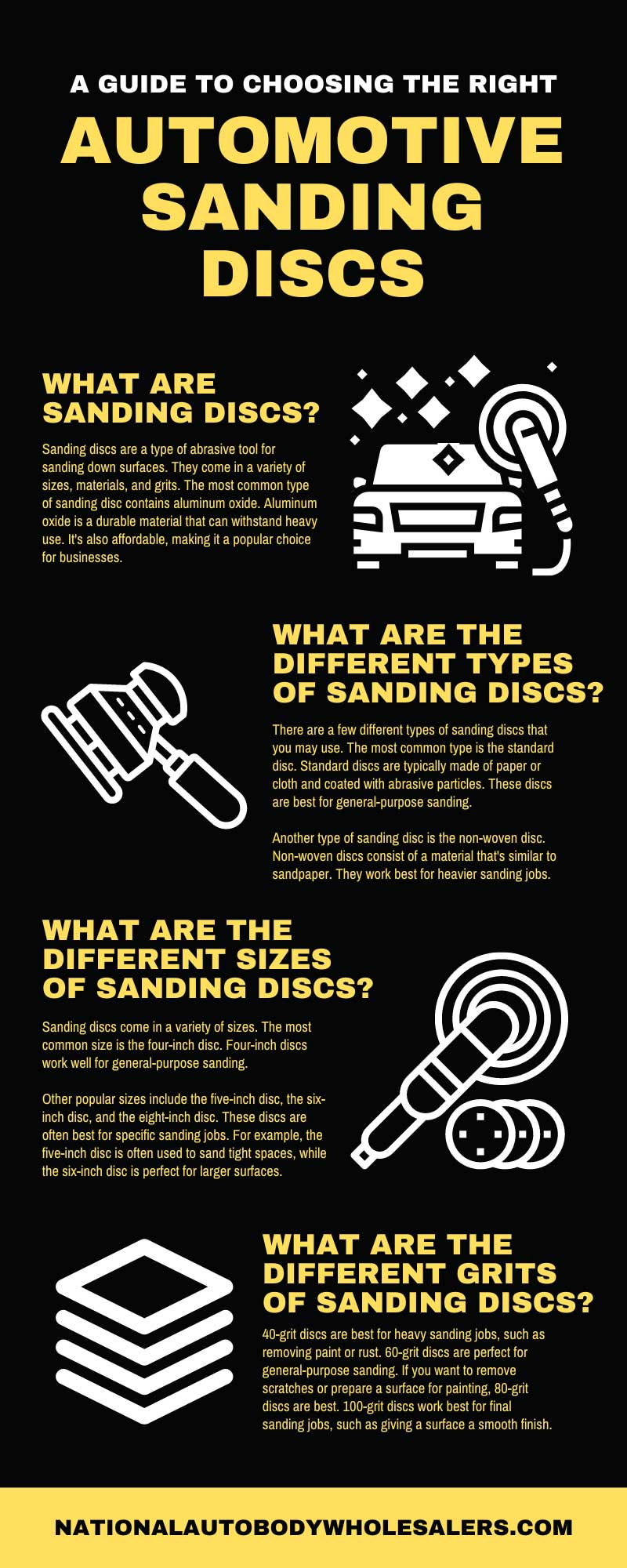Maybe you’re starting a new detailing business or have been in the game and want to add automotive sanding to your services. Either way, you will need to choose the suitable sanding discs for the job.
In this guide, we’ll go over some of the things you need to consider when choosing automotive sanding discs to make the best decision for your business.
What Are Sanding Discs?
Sanding discs are a type of abrasive tool for sanding down surfaces. They come in a variety of sizes, materials, and grits. The most common type of sanding disc contains aluminum oxide. Aluminum oxide is a durable material that can withstand heavy use. It’s also affordable, making it a popular choice for businesses.
What Are the Different Types of Sanding Discs?
There are a few different types of sanding discs that you may use. The most common type is the standard disc. Standard discs are typically made of paper or cloth and coated with abrasive particles. These discs are best for general-purpose sanding.
Another type of sanding disc is the non-woven disc. Non-woven discs consist of a material that’s similar to sandpaper. They work best for heavier sanding jobs.
Finally, there are also abrasive discs. Abrasive discs are best for heavy-duty sanding jobs. Abrasive discs use various materials, including aluminum oxide, silicon carbide, and ceramic.
What Are the Different Sizes of Sanding Discs?
Sanding discs come in a variety of sizes. The most common size is the four-inch disc. Four-inch discs work well for general-purpose sanding.
Other popular sizes include the five-inch disc, the six-inch disc, and the eight-inch disc. These discs are often best for specific sanding jobs. For example, the five-inch disc is often used to sand tight spaces, while the six-inch disc is perfect for larger surfaces.
What Are the Different Grits of Sanding Discs?
Sanding discs also come in a variety of different grits. The most common grits are 40, 60, 80, and 100.
40-grit discs are best for heavy sanding jobs, such as removing paint or rust. 60-grit discs are perfect for general-purpose sanding. If you want to remove scratches or prepare a surface for painting, 80-grit discs are best. 100-grit discs work best for final sanding jobs, such as giving a surface a smooth finish.
Picking the Right Sanding Disc for Each Application
Now that you know more about the different auto-body sanding discs, it’s time to learn how to pick the right disc for each application.
For general-purpose sanding, you’ll want to use a disc with a 40-grit or 60-grit. For light sanding jobs, you’ll want to use a disc with an 80-grit. You’ll want to use a disc with a 100-grit for final sanding jobs.
You’ll also want to consider the surface type when choosing a sanding disc. For example, if you’re working on a painted surface, you’ll want to use a disc with softer abrasive particles.
If you’re working on a delicate surface, such as wood or plastic, you’ll want to use a disc with finer abrasive particles.
Finally, you’ll also want to consider the sanding job you will be doing. If you’re doing a heavy sanding job, such as removing paint or rust, you’ll want to use a disc with a higher grit.
But if you’re doing a light sanding job, such as removing scratches or preparing a surface for painting, you’ll want to use a disc with a lower grit.
Tools Commonly Used With Sanding Discs
When using sanding discs, you’ll also need to have a few other tools on hand.
First, you’ll need a power drill. A power drill will make it easier to attach the disc to the sanding pad.
You’ll also need a sanding pad. A sanding pad is a tool that works in conjunction with sanding discs.
Finally, you’ll need a dust mask. A dust mask will help protect your lungs from the harmful particles produced when sanding.
Tips When Using Sanding Discs
Now that you know how to choose the right sanding disc, it’s time to learn some tips on using them.
Backing Pads
When sanding discs, you’ll want to ensure that you’re using the right backing pad. The backing pad is the part of the disc that attaches to the power drill.
There are two main types of backing pads: rigid and flexible. Rigid backing pads are best for hard surfaces, such as concrete or stone.
Flexible backing pads are best for softer surfaces, like wood or plastic.
Discs With Hook and Loop Attachments
If you’re doing a lot of sanding, you might consider getting discs with hook and loop attachments. Hook and loop discs are more accessible to change than traditional sanding discs.
To change a hook and loop disc, peel it off the backing pad and then stick on a new one. This design makes changing discs a lot faster and easier.
Wear Protective Gear
When using sanding discs, it’s essential to wear the proper protective gear.
You should always wear a dust mask when using sanding discs. A dust mask will help protect your lungs from the harmful particles produced when sanding.
You should also wear gloves and eye protection. Gloves will help protect your hands from abrasive particles, and eye protection will help protect your eyes from flying debris.
Change Your Discs Often
When using sanding discs, it’s crucial to change them often. This is because the abrasive particles on the disc will eventually wear down.
If you don’t change your discs often, you’ll do a lot of work without much result.
Don’t Apply Too Much Pressure
When sanding, it’s important not to apply too much pressure. Too much pressure can damage the surface you’re sanding and cause the disc to wear out faster.
Now that you know how to choose the best sanding disc, it’s time to put that knowledge to use. Whether you’re doing a light sanding job or a heavy one, selecting the right disc and using it properly will help you achieve the best results.
Focus on finding the automotive sanding discs that will suit your needs the most depending on the surface you’re working on, what type of sander you’re using, and how much pressure you plan on applying.
National Autobody Wholesalers has a wide variety of sanding discs for you to choose from to get the perfect match for your car.


